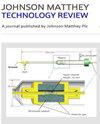Microbial Production of Hydrogen
IF 2
4区 化学
Q4 CHEMISTRY, PHYSICAL
引用次数: 0
Abstract
Hydrogen offers a source of energy that does not produce any greenhouse gas when combusted. However, some manufacturing methods of hydrogen consume large amounts of energy and produce carbon dioxide as a by-product. The production of hydrogen by bacteria is an attractive alternative, because it is not energy intensive and - under the right conditions - does not release greenhouse gases. In this review, we introduce the five known ways by which bacteria can evolve hydrogen. We then describe methods to encapsulate living bacteria in synthetic layers, called coatings, for applications in bioreactors. We review the few examples in which biocoatings have been used to produce hydrogen via the photo-fermentation method. Although not used in biocoatings so far, the dark fermentation method of hydrogen production avoids the need for illumination while offering a high yield with low oxygen evolution. We identify the potential for using genetically-modified bacteria in future research on biocoatings.微生物产氢
氢提供了一种能源,燃烧时不会产生任何温室气体。然而,一些制造氢气的方法消耗大量的能源,并产生二氧化碳作为副产品。利用细菌生产氢气是一种很有吸引力的替代方法,因为它不需要消耗大量能源,而且在适当的条件下不会释放温室气体。在这篇综述中,我们介绍了五种已知的细菌进化氢的方式。然后,我们描述了将活细菌封装在称为涂层的合成层中的方法,用于生物反应器。本文综述了生物膜利用光发酵法制备氢气的几个实例。虽然到目前为止还没有用于生物涂层,但暗发酵制氢的方法避免了对照明的需求,同时提供了低析氧的高产量。我们确定了在未来生物涂层研究中使用转基因细菌的潜力。
本文章由计算机程序翻译,如有差异,请以英文原文为准。
求助全文
约1分钟内获得全文
求助全文
来源期刊

Johnson Matthey Technology Review
CHEMISTRY, PHYSICAL-
CiteScore
4.30
自引率
4.30%
发文量
48
审稿时长
12 weeks
期刊介绍:
Johnson Matthey Technology Review publishes articles, reviews and short reports on science enabling cleaner air, good health and efficient use of natural resources. Areas of application and fundamental science will be considered in the fields of:Advanced materials[...]Catalysis[...][...]Characterisation[...]Electrochemistry[...]Emissions control[...]Fine and speciality chemicals[...]Historical[...]Industrial processes[...]Materials and metallurgy[...]Modelling[...]PGM and specialist metallurgy[...]Pharmaceutical and medical science[...]Surface chemistry and coatings[...]Sustainable technologies.
 求助内容:
求助内容: 应助结果提醒方式:
应助结果提醒方式:


